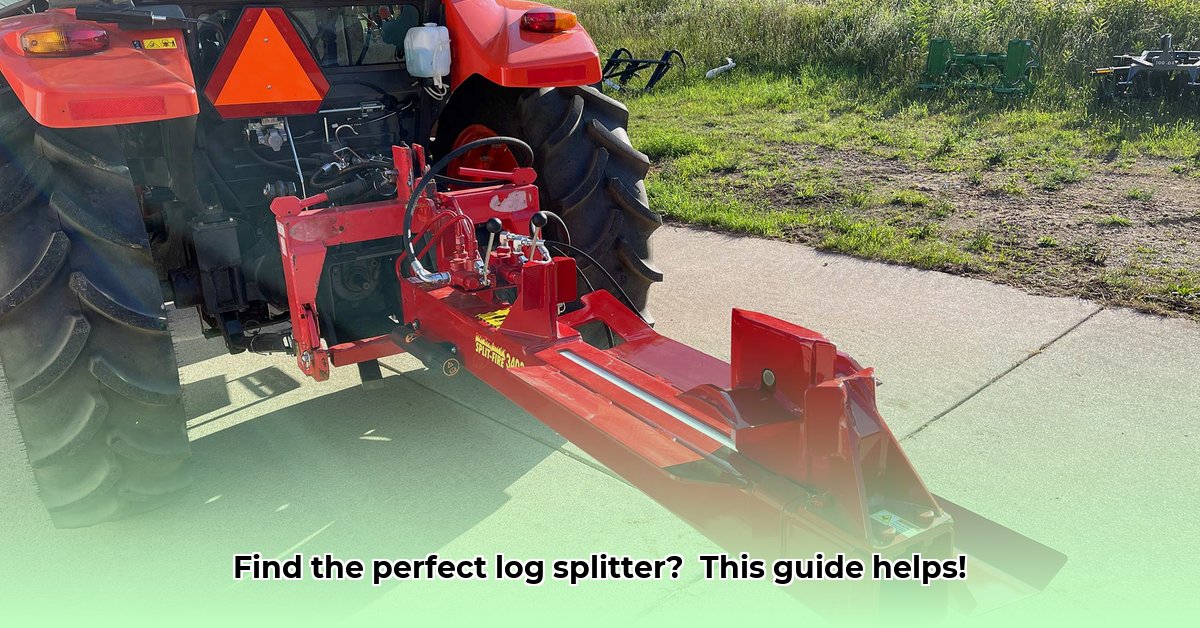
Choosing the right tractor-powered log splitter can be daunting. This guide simplifies the process by comparing the two primary types: three-point hitch and PTO (Power Take-Off) models. We'll analyze their advantages and disadvantages, helping you make an informed decision based on your tractor's capabilities and your wood-splitting needs. For more detailed information, check out this helpful guide.
Understanding Three-Point Hitch and PTO Log Splitters
Two main types of tractor-powered log splitters dominate the market: three-point hitch and PTO models. Each leverages your tractor's power differently, resulting in distinct operational characteristics and cost implications.
Three-Point Hitch Log Splitters
A three-point hitch splitter directly connects to your tractor's three-point hitch system. The tractor's hydraulics power the splitting ram. This is generally a simpler, more affordable setup. Think of it as a direct extension of your tractor's hydraulic power.
Pros:
- Lower initial cost.
- Simple installation and setup.
- Compact storage – it remains attached to the tractor.
Cons:
- Performance heavily dependent on your tractor's hydraulic capacity (GPM). Insufficient GPM leads to slow splitting, especially with larger logs.
- Can strain your tractor's hydraulic system if it's not powerful enough.
PTO (Power Take-Off) Log Splitters
PTO splitters utilize a separate hydraulic pump driven by your tractor's PTO shaft. This independent system means the splitting power isn't limited by your tractor's main hydraulic system. This is like adding a dedicated, powerful engine specifically for splitting.
Pros:
- Consistent splitting power, regardless of your tractor's hydraulic capacity.
- Generally faster splitting speeds, especially with larger logs.
Cons:
- Higher initial cost due to the additional hydraulic pump and components.
- More complex installation requiring a PTO shaft connection and hydraulic lines.
- Increased maintenance requirements compared to three-point hitch models.
Three-Point Hitch vs. PTO: A Comparative Analysis
The following table summarizes the key differences:
| Feature | 3-Point Hitch | PTO |
|---|---|---|
| Power Source | Tractor's hydraulic system | Dedicated hydraulic pump via tractor's PTO |
| Installation | Simple, direct connection | Requires PTO shaft and hydraulic lines |
| Cost | Typically less expensive | Generally more expensive |
| Hydraulic Demand | High; dependent on tractor's GPM | Lower; independent of tractor's hydraulics |
| Speed | Can be slow with lower GPM tractors | Generally faster |
| Maintenance | Typically simpler | Potentially more complex |
Choosing the Right Log Splitter: A Step-by-Step Guide
Before purchasing, consider these factors:
Assess your wood-splitting needs: How much wood will you split regularly? How large are the logs you typically handle? More frequent use of larger logs points toward a more powerful PTO splitter.
Check your tractor's specifications: Determine your tractor's horsepower (HP) and hydraulic flow rate (GPM). This data is crucial for determining the suitability of a three-point hitch splitter. Insufficient GPM severely impacts performance.
Evaluate the pros and cons: Carefully weigh the advantages and disadvantages of both three-point hitch and PTO models in relation to your needs and tractor capabilities. Consider factors like cost, maintenance, and splitting speed.
Factor in long-term costs: Account for initial purchase price, fuel costs (if applicable), maintenance expenses, and potential wear and tear on your tractor's hydraulic system.
Prioritize safety: Always choose a splitter with safety features like automatic shutoffs, two-handed controls, and a stable base. Safety should never be compromised.
Consider additional features: Options like a four-way wedge, stroke limiter, and log shelf improve efficiency and safety. Assess your needs and budget accordingly.
Research reputable brands and warranties: A good warranty and readily available support can save you headaches down the road.
Key Takeaways
- PTO splitters offer more consistent and often faster performance, especially for users with lower tractor hydraulic capacity or those splitting large quantities of wood regularly.
- Three-point hitch splitters provide a cost-effective solution if your tractor has sufficient hydraulic capacity and your wood-splitting needs are less demanding.
- Understanding your tractor's hydraulic capacity (GPM) is paramount when choosing a three-point hitch splitter.
- Always prioritize safety features, regardless of the type of splitter you choose.
By carefully considering these points, you can select the tractor hydraulic log splitter that perfectly balances your needs, your tractor's capabilities, and your budget, ensuring efficient and safe wood splitting for years to come.